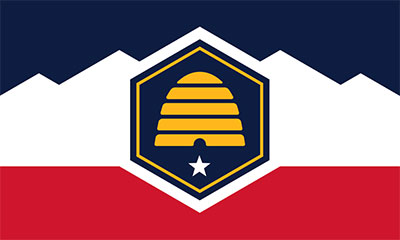Utah Flag

FOUNDATION
Blue represents our lakes and our wide-open skies, and beloved principles such as knowledge, freedom, optimism, and tradition.
BEEHIVE
The beehive represents Utah’s history and a sense of community, plus "Industry," our state’s slogan.
HEXAGON
The gold hexagon rim around the beehive stands for strength and unity.
MOUNTAINS
The white segment represents peace and Utah’s snowy mountain peaks, which recognize the state’s Indigenous people. That includes the eight Tribal Nations, who have lived here since time immemorial, and who are still here and still thriving.
RED ROCKS
The red rock valley represents Southern Utah’s rugged canyons, which millions of people around the world travel to see.
STAR
At the foundation of the beehive is a five-pointed star, which represents hope and the year 1896, when Utah was admitted to statehood. These are enclosed by a hexagon, which symbolizes the strength of Utah’s people.
COLORS
The red, white, and blue colors represent Utahns’ love of freedom and our country. Gold represents prosperity and industry.
HISTORIC FLAG:
The Legislature of Utah by an act, approved April 3, 1896, provides for the State seal and specifies: "That 'The Great Seal of the State of Utah' shall be two and one-half inches in diameter, with the following device inscribed thereon: "In the center thereof a shield, with the American eagle with outstretched wings perched thereon; the top portion of said shield thereof pierced by six arrows; across the shield, below the arrows, the word 'Industry' appears, and beneath the word 'Industry' a beehive, on either side of which are growing sego lilies. Directly below the beehive are the figures '1847,' and on either side of said shield is our National flag. Encircling all, near the outer edge of said Seal, beginning at the lower left hand portion and ending at the lower right hand portion thereof, are the words, 'The Great Seal of the State of Utah,' at the base are the figures '1896'."</p><p>Each state in the country has customarily adopted a state Flag. Since the colonial Days of 1775 each state designed their flags to help distinguish the ideas and tradition of that particular state. The original Utah State Flag was adopted by the State Legislature in 1896 and revised in 1913. The beehive on the shield stands for hard work and industry.</p><p> The date 1847 is the year the Mormons came to Utah. A bald eagle, the United States national bird, perches atop the shield and symbolizes protection in peace and war. The sego lily is a symbol of peace and a U.S. flag appears on each side, symbolizing Utah's support to the nation. The Utah State Flag, as we know it today, was originally designed for the battleship Utah in 1912. It was later made the official flag of Utah when Governor William Spry signed House Joint Resolution I in 1913.

